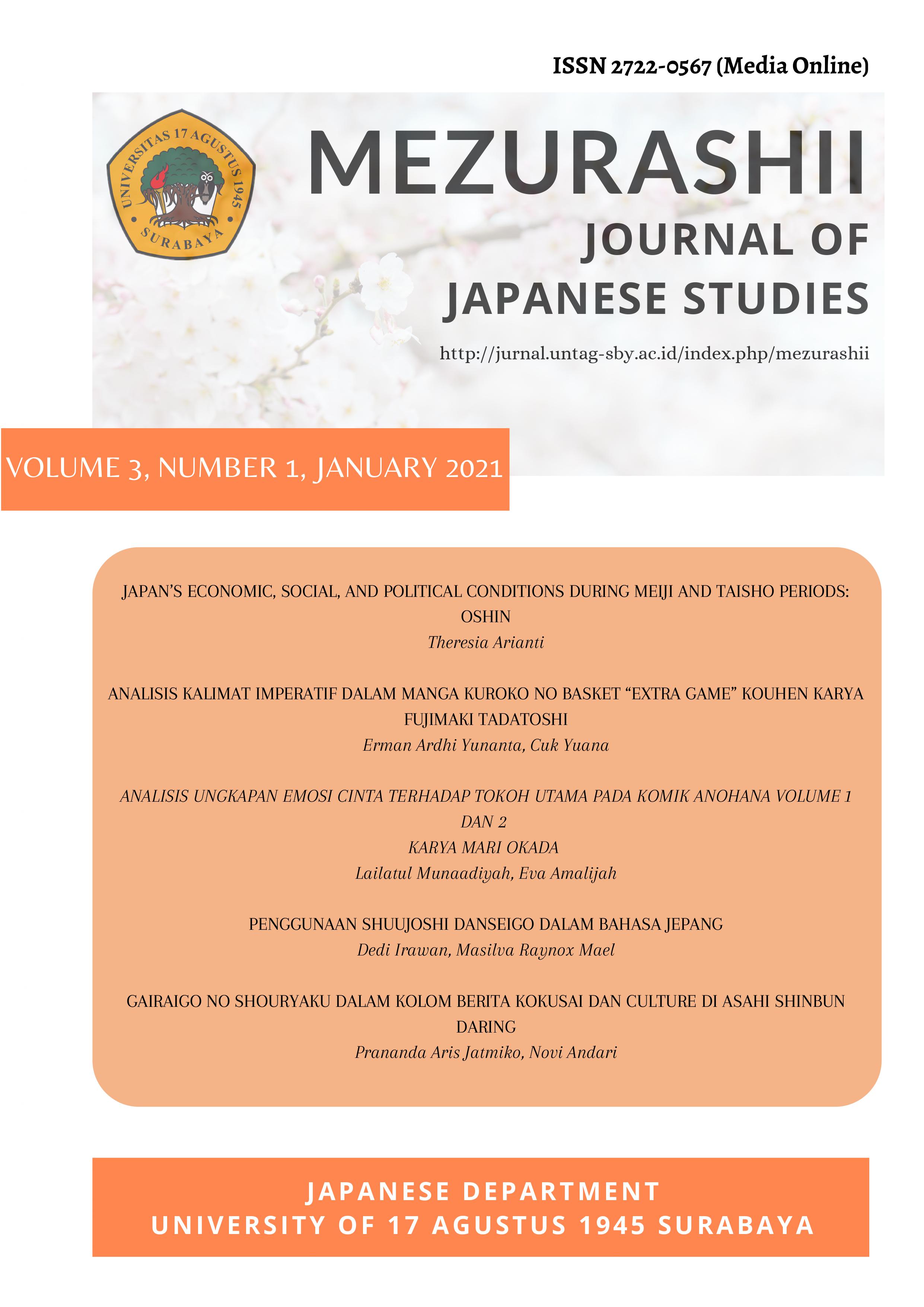JAPAN’S ECONOMIC, SOCIAL, AND POLITICAL CONDITIONS DURING MEIJI AND TAISHO PERIODS: OSHIN
DOI:
https://doi.org/10.30996/mezurashii.v3i1.4406Abstract
Abstrak: Studi ini didasarkan pada serial TV Oshin yang disiarkan perdana pada 1983. Oshin, tokoh utama, lahir di Jepang pada tahun 1900 pada periode Meiji dan menghabiskan masa remajanya pada periode Taisho. Kebanyakan penelitian mengenai Jepang sebelumnya belum memasukan Oshin dan Face-Threatenig Acts sebagai landasan studi. Disinilah kekurangan yang akan diisi oleh studi ini dimana studi ini akan menunjukan sisi gelap Jepang pada periode Meiji dan Taisho melalui Face-Threatening Acts yang terdapat dalam dorama Oshin. Hasil studi menunjukan bahwa Jepang mengalami masalah kemiskinan pada zaman Meiji serta permasalahan politk pada zaman Taisho. Studi ini menunjukan bahwa Face-Threatening Acts dapat merepresentasikan latar belakang tempat dan waktu dari sebuah cerita.
Kata kunci: Oshin, Face-Threatening Acts, periode Meiji, periode Taisho
Abstract: This study is based on a Japanese TV series titled Oshin which was firstly aired in 1983. Oshin, the main character, was born in Japan in 1900 during Meiji period and spent her teenagehood in Taisho period. Previous studies examining Japan mostly do not include Oshin and Face Threatening Acts in the methods/materials used. These are the gaps the current study is fulfilling since this study aims to investigate Oshin’s portrayal of Japan, by using Face Threatening Acts theory, which can reveal Japan’s dark history to people outside Japan. Findings show that face threatening acts in the conversations amongst the characters reflect Japan’s poverty in Meiji period. The face threatening acts also reveal the “underground” political movement emerged in Taisho period as well as laborers’ bad working condition. This study shows how face threatening acts in a conversation can reflect the condition of the place and time when the conversation occurs. This study will also open the society’s eyes on what happened in Japan during Meiji and Taisho periods so that more people can learn from the history.
Keywords: Oshin, Face-Threatening Acts, Meiji period, Taisho period
Downloads
References
Fahmi, Irham. 2014. Pengantar Manajemen Keuangan. Bandung : Alfabeta.
Muhardi. 2011. Manajemen Operasi : Suatu pendekatan kuantitatif untuk pengambilan keputusan. Bandung : Refika Aditama.
Handoko, Hani. 2010. Manajemen Personalia & Sumber daya Manusia. Yogyakarta : BPFE UGM.
Wiliam J. Steven 2009. Management Operation. Prentice Hall. Uk.
Russel. R. S. & Taylor B.W. 2011. Operation Management Along the Supply Chain. 7th ed. NJ : Mley.
Prasetya, Hery & Fitri Lukiastuti. 2009. Manajemen operasi. Yogyakarta : Media Pressindo.
Sofjian, Assauri. 1993. Manajemen Produksi dan Operasi. Jakarta : Fe-UI.
Haeder Ali, Tubagus. 1992. Prinsip-Prinsip Networking Planning. Jakarta : Gramedia.
Kerzener, Harold, Phd. 1984. Project Management : A System Approach to Planning Schedulling, and Controlling. Van Nonstrand : Reinhold Company.
Soeharto Imam. 1990. Manajemen Proyek Industri: Persiapan, Pelaksanaan, Pengelolaan, Jakarta : Erlangga.
Arianti. 2002. Penerapan Diagram Network Planing Dengan CPM Dalam Efisiensi Waktu Dan Biaya Pada Perusahaan Garmen Collection. Malang.
Ghofar. 2005. Network Planing Dengan CPM Untuk Meningkatkan Efesiensi Waktu dan Biaya Pada Pembangungan Jembatan CV. Putra Dewata. Malang.
Sakdiyah. 2004. Network Planing Dengan CPM Dalam Usaha Meningkatkan Efisiensi Biaya dan Waktu Pada Proyek Pembangunan Perkantoran di PT. Nilano. Malang.
Iwabuchi, K. (2015). Pop-culture diplomacy in Japan: soft power, nation branding and the question of ‘international cultural exchange’. Doi: https://doi.org/10.1080/10286632.2015.1042469. Retrieved from https://www.tandfonline.com/doi/full/10.1080/10286632.2015.1042469?scroll=top&needAccess=true
Nolte, S. H. (2011). Individualism in Taisho Japan. Doi: https://doi.org/10.2307/2057149. Retrieved from https://www.cambridge.org/core/journals/journal-of-asian-studies/article/individualism-in-taisho-japan/111D54CEC1D36821697305ACB3E69F95
Paltridge, B. (2012). Discourse analysis. London, UK: Bloomsbury Publishing Plc.
Sullivan, N. & Schatz, R. T. (2009). Effects of Japanese national identification on attitudes toward learning English and self-assessed English proficiency. International Journal of Intercultural Relations, 33(6), 486-497. doi:10.1016/j.ijintrel.2009.03.001
Takayoshi, M. (1966). The development of democracy in Japan-taisho democracy: Its flowering and breakdown. The Developing Economies. 4(4), 612-632. doi: 10.1111/j.1746-1049.1966.tb00495.x
Wagner, L. C. (2004). Positive- and Negative-Politeness Strategies: Apologizing in the Speech Community of Cuernavaca, Mexico. Intercultural Communication Studies, 13(1), 22-30. Retrieved from http://web.uri.edu/iaics/files/02-Lisa-C.-Wagner.pdf
Downloads
Published
How to Cite
Issue
Section
License
Authors publishing in the Journal will be asked to sign a Copyright Assignment Form. In signing the form, it is assumed that authors have obtained permission to use any copyrighted or previously published material. All authors must read and agree to the conditions outlined in the form, and must sign the form or agree that the corresponding author can sign on their behalf. Articles cannot be published until a signed form has been received.It is a condition of publication that authors assign copyright or license the publication rights in their articles, including abstracts, to email jurnalmezurashii@untag-sby.ac.id. . This enables us to ensure full copyright protection and to disseminate the article, and of course the Journal to the widest possible readership in print and electronic formats as appropriate.








